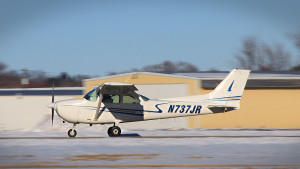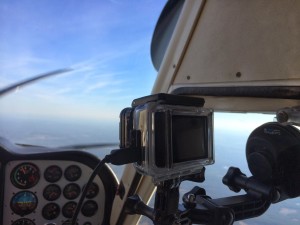Flight training costs are something that is often quietly acknowledged but rarely openly discussed. If you ask me, I think the main reason for this is not that flight training costs are high, but rather that there are so many variables that factor into accurately assessing how much a given individual will spend toward their training.
In this post, I’m going to take a look at the costs that were involved with my own Colorado flight training, as well as share some tips to help make time in the cockpit more effective and cost conscious.
1. Have your finances in order to avoid gaps in training
From a financial standpoint, I’d recommend having the money for flight training set aside before starting. Whether it’s from a loan, scholarship, or scrounging up pennies in your savings, being able to invest in flight training, uninterrupted, is key. I took more than eleven years off between when I started flight training and when I finally finished up my certificate. The reason: money and time. This extreme break in my training made it so I had to re-learn techniques that were taught early-on and I can assure that it did absolutely nothing toward the objective of saving either money or time.
2. Give yourself enough flying time to fully understand and retain your training
Time is the other major factor where student pilots can have a direct impact on how long it takes to earn their certificate and how much they will spend in the process. Some people can learn everything they need to by flying once a week or even less. For others, it might be more beneficial to fly two or three times a week. Just keep in mind that learning to fly is unlike anything you’ve done in the past and your retention of what you’re learning will be key. It’s been said before that the cockpit of an airplane is a horrible classroom; It’s cramped, loud, and full of distractions.
3. Use different tools to help you review your flights and check your progress
Regardless of one’s ability to retain information from the cockpit classroom, student pilots should make sure to allow plenty of time for flight briefing and debriefing with their CFI as well as home study. There are different iPad apps such as ForeFlight and CloudAhoy can be great for reviewing the flight track and discussing certain points. Using a GoPro patched into the cockpit audio can also be invaluable for debriefing and reviewing your flights. But, as a word of caution, as a student pilot, only use these devices in a “passive mode” where you won’t become distracted by them. For example, if you’re running a GoPro, press the record button before you start the engine and then forget about it until after the engine shuts down. Minimizing distraction from technology is key for new and experienced pilots alike.
4. Study your flight training at home with Flight Simulators
Another great way to learn basic aviation knowledge is to purchase an inexpensive home flight simulator such as Microsoft’s Flight Simulator X Steam Edition or Lockheed Martin’s Prepar3d. While the time cannot be logged toward meeting the FAA’s requirements, home flight simulators can help students gain an understanding of how to fly basic maneuvers and aircraft handling. Home simulators become particularly useful for instrument training or when connected via the internet to online air traffic control networks like VATSIM or PilotEdge. Here, using their simulator, pilots of all skill levels can interact with other people simulating the role of air traffic controllers. Pilots quickly learn that flying has its own language and being able to practice speaking it when in a low stress, home environment is incredibly useful. As always, make sure that your instructor provides some input to make sure that you’re not creating and reinforcing bad flying habits with your home simulator.
5. Practice your skills in an FAA approved flight simulator
An even better solution to extending your training dollars is to spend some time with an instructor in an FAA approved flight simulator, such as the Redbird FMX full-motion simulator. Unlike home simulators, time spent in the Redbird FMX can be logged toward meeting certain FAA requirements for private and instrument students. Simulator time is incredibly valuable since it allows you to practice scenario-based training exercises in a place that is much more conducive to learning than the cockpit of your training aircraft. Pause, reset, change the weather, practice maneuvers without leaving the airport. More and more flight schools are seeing the benefit of having full motion simulators incorporated into their training programs and it’s definitely something student pilots can and should take advantage of!
So, how much will it cost?
I wrapped up my flight training at Aero-Sphere in the fall of 2013. Note: These prices are for the front range of Colorado. Cost at various training locations, like Boulder flight training vs. Longmont flight training, can and will most certainly vary.
Opening up my logbook, you’ll find that during my training I logged:
35.1 Dual (time spent flying with an instructor) + 10.2 Solo = 45.3 hours at a cost of: $6,036 or an average of about $133.25/hour.
Industry groups like to say that the average to attain a private pilot certificate is more like 60 hours but the topics I discussed above are what I did and it allowed me to get closer to the FAA’s minimum requirement of 40 hours. There are a lot of factors that go into that number, many of which are directly in the hands of the student and their commitment to keeping costs down.
Excluded from this total are things like the flight physical, written exam, FAA examiner fee, and any incidental expenses like test prep, headsets, and various pilot supplies. A good rule of thumb that gets is to have anywhere from $8,000 to $13,000 ready to commit to training, incidental expenses, and to have to rent with after you achieve your certificate – after all, a pilot’s license is useless if you’re not going to get out there and use it!
Above all else, if you want to maximize your money, prepare! By having your finances in order, prepping before lessons, and using tools like flight tracker and flight simulators you will be able to gain a deep understanding of this skill, while also maximizing your costs! As always, stay safe out there and we hope to see you for flight training at Aero-Sphere!





